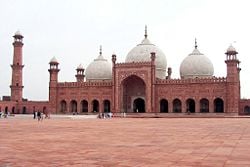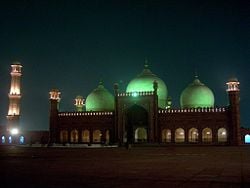Difference between revisions of "Badshahi Mosque" - New World Encyclopedia
Dan Davies (talk | contribs) |
Dan Davies (talk | contribs) |
||
| Line 9: | Line 9: | ||
[[Image:Badshahi Masjid at night on July 20 2005.jpg|thumb|right|250px|Badshahi Masjid at night]] | [[Image:Badshahi Masjid at night on July 20 2005.jpg|thumb|right|250px|Badshahi Masjid at night]] | ||
| − | Built under the patronage of the sixth [[Mughal]] Emperor, [[Aurangzeb|Aurangzeb Alamgir]], the mosque came to completion in 1673. | + | Built under the patronage of the sixth [[Mughal]] Emperor, [[Aurangzeb|Aurangzeb Alamgir]], the mosque came to completion in 1673. Aurangzeb's foster brother Muzaffar Hussain (also known as Fidaie Khan Koka), governor of Lahore 1671 to 1675, supervised the building. He also served as Master of Ordnance to the emperor. The construction of the mosque took about two years from May 1671 to April 1673. Built opposite the [[Lahore Fort]], a position that illustrated its importance in the Mughal Empire, Badshahi Mosque took an honored place in the empire. In conjunction with the building of Badshahi, the Emperor had a new gate built at the fort named [[Alamgiri Gate]]. |
Badshahi Mosque had badly damaged and misused during [[Sikh]] Rule <!--{{Fact|date=November 2007}}—>. When the Sikhs ruled Lahore, they used the mosque for horse stables for the many horses, camels, and other animals that they used. They also would steal the jewels from the mosque, such as marble, rubies, gold, and other valuables. Sikhs forbade Muslims from entering the mosque to worship, the government granting only a small place outside the mosque where they could worship. | Badshahi Mosque had badly damaged and misused during [[Sikh]] Rule <!--{{Fact|date=November 2007}}—>. When the Sikhs ruled Lahore, they used the mosque for horse stables for the many horses, camels, and other animals that they used. They also would steal the jewels from the mosque, such as marble, rubies, gold, and other valuables. Sikhs forbade Muslims from entering the mosque to worship, the government granting only a small place outside the mosque where they could worship. | ||
| − | Even when the British took control of India, they | + | Even when the British took control of India, they used the mosque for military training including rifle and cannon fire range. Sensing Muslim hate for them, the British demolished a large portion of the wall of the mosque, rendering the mosque unusable as a rallying place for anti-British planning. The British later returned the mosque to Muslims as a good will gesture, even though the structure had become dilapidated from misuse and neglect. The Badshahi Mosque Authority restored the holy place to its original glory. |
From 1852 onwards, piecemeal repairs were carried out under the supervision of the Badshahi Mosque Authority. Extensive repairs were carried out from 1939 to 1960 at a cost of about 4.8 million rupees, which brought the mosque to its original shape and condition. The blueprint for the repairs was prepared by the late architect Nawab Zen Yar Jang Bahadur. | From 1852 onwards, piecemeal repairs were carried out under the supervision of the Badshahi Mosque Authority. Extensive repairs were carried out from 1939 to 1960 at a cost of about 4.8 million rupees, which brought the mosque to its original shape and condition. The blueprint for the repairs was prepared by the late architect Nawab Zen Yar Jang Bahadur. | ||
Revision as of 19:13, 14 May 2008
The Mughal Emperor Aurangzeb built the Badshahi Mosque (Urdu: بادشاھی مسجد), or the 'Emperor's Mosque', in 1673 in Lahore, Pakistan. The mosque displays an excellent example of Mughal era architecture. The second largest mosque in Pakistan, after the Faisal Mosque in Islamabad, the sanctuary accommodates over 55,000 worshipers. Jama Masjid in Delhi, India, closely resembles the architecture and design of the Badshahi Masjid. Badshahi Masjid is one of the locations where Qari' Abdul Basit recited the Qur'an.
History
Built under the patronage of the sixth Mughal Emperor, Aurangzeb Alamgir, the mosque came to completion in 1673. Aurangzeb's foster brother Muzaffar Hussain (also known as Fidaie Khan Koka), governor of Lahore 1671 to 1675, supervised the building. He also served as Master of Ordnance to the emperor. The construction of the mosque took about two years from May 1671 to April 1673. Built opposite the Lahore Fort, a position that illustrated its importance in the Mughal Empire, Badshahi Mosque took an honored place in the empire. In conjunction with the building of Badshahi, the Emperor had a new gate built at the fort named Alamgiri Gate.
Badshahi Mosque had badly damaged and misused during Sikh Rule . When the Sikhs ruled Lahore, they used the mosque for horse stables for the many horses, camels, and other animals that they used. They also would steal the jewels from the mosque, such as marble, rubies, gold, and other valuables. Sikhs forbade Muslims from entering the mosque to worship, the government granting only a small place outside the mosque where they could worship.
Even when the British took control of India, they used the mosque for military training including rifle and cannon fire range. Sensing Muslim hate for them, the British demolished a large portion of the wall of the mosque, rendering the mosque unusable as a rallying place for anti-British planning. The British later returned the mosque to Muslims as a good will gesture, even though the structure had become dilapidated from misuse and neglect. The Badshahi Mosque Authority restored the holy place to its original glory.
From 1852 onwards, piecemeal repairs were carried out under the supervision of the Badshahi Mosque Authority. Extensive repairs were carried out from 1939 to 1960 at a cost of about 4.8 million rupees, which brought the mosque to its original shape and condition. The blueprint for the repairs was prepared by the late architect Nawab Zen Yar Jang Bahadur.
In 2000, the repair work of marble inlay in the main vault was repaired under the supervision of Saleem Anjum Qureshi.
On the occasion of the second Islamic Summit held at Lahore on February 22, 1974, thirty-nine heads of Muslim states offered their Friday prayers in the Badshahi Masjid, led by Maulana Abdul Qadir Azad, the 'Khatib' of the mosque.
Recently a small museum has also been added to the mosque complex. It contains relics of Muhammad, his cousin Hazrat Ali Razi allah Anho, and his daughter, Hazrat Fatima ZahraHazi allah anha.
Design Characteristics
Like the character of its founder, the mosque is bold, vast and majestic in its expression. It was the largest mosque in the world for a long time.
The interior has rich embellishment in stucco tracery (Manbatkari) and panelling with a fresco touch, all in bold relief, as well as marble inlay.
The exterior is decorated with stone carving as well as marble inlay on red sandstone, specially of loti form motifs in bold relief. The embellishment has Indo-Greek, Central Asian and Indian architectural influence both in technique and motifs.
The skyline is furnished by beautiful ornamental merlons inlaid with marble lining adding grace to the perimeter of the mosque. In its various architectural features like the vast square courtyard, the side aisles (dalans), the four corner minars, the projecting central transept of the prayer chamber and the grand entrance gate, is summed up the history of development of mosque architecture of the Muslim world over the thousand years prior to its construction in 1673.
The north enclosure wall of the mosque was laid close to the Ravi River bank, so a majestic gateway could not be provided on that side and, to keep the symmetry the gate had to be omitted on the south wall as well. Thus a four aiwan plan like the earlier Delhi Jamia Masjid could not be adopted here.
The walls were built with small kiln-burnt bricks laid in kankar, lime mortar (a kind of hydraulic lime) but have a veneer of red sandstone. The steps leading to the prayer chamber and its plinth are in variegated marble.
The prayer chamber is very deep and is divided into seven compartments by rich engraved arches carried on very heavy piers. Out of the seven compartments, three double domes finished in marble have superb curvature, whilst the rest have curvilinear domes with a central rib in their interior and flat roof above. In the eastern front aisle, the ceiling of the compartment is flat (Qalamdani) with a curved border (ghalatan) at the cornice level.
The original floor of the courtyard was laid with small kiln-burnt bricks laid in the Mussalah pattern. The present red sandstone flooring was laid during the last thorough repairs (1939-60). Similarly, the original floor of the prayer chamber was in cut and dressed bricks with marble and Sang-i-Abri lining forming Mussalah and was also replaced by marble Mussalah during the last repairs.
There are only two inscriptions in the mosque:
- one on the gateway
- the other of Kalimah in the prayer chamber under the main high vault.
Measurements
- Courtyard: 528'-8" x 528'-4" (Area: 278,784 ft2), divided into two levels: the upper and the lower. In the latter, funeral prayers can also be offered.
- Prayer Chamber: 275'-8" x 83'-7" x 50'-6" high, with its main vault 37'-3" x 59'-4" high but with the meplons 74'-6." (Area: 22,825 ft2)
- Corner Minars: 67' in circumference, 176'-4" high are in four stages and have a contained staircase with 204 steps.
- Central Dome: Diameter 65' at bottom (at bulging 70'-6"); height 49'; pinnacle 24 ft and neck 15 ft high.
- Side Domes: Diameter 51'-6" (at bulging 54'-2"); height 32 ft; pinnacle 19 ft; neck 9'-6" high.
- Gateway: 66'-7" x 62'-10" x 65 high including domelets; vault 21'-6" x 32'-6" high. Its three sided approach steps are 22 in number.
- Side aisles (Dalans): 80 in number. Height above floor 23'-9"; plinth 2'-7."
- Central Tank: 50' x 50' x 3' deep (Area: 2,500 ft2)
Gallery
See also
- Lahore Fort
- Islamic architecture
- Timeline of Islamic history
- Islamic art
- List of mosques
ReferencesISBN links support NWE through referral fees
External links
- Pictures and information about Badshahi Masjid. Retrieved May 14, 2008.
- A photograph of Badshahi Masjid. Retrieved May 14, 2008.
- Badshahi Mosque Architectural Review. Retrieved May 14, 2008.
- Satellite image of Badshahi Mosque from Google Maps. Retrieved May 14, 2008.
| Emperors: | Babur - Humayun - Akbar - Jahangir - Shah Jahan - Aurangzeb - Lesser Mughals |
| Events: | First battle of Panipat - Second battle of Panipat - Third battle of Panipat |
| Architecture: | Humayun's Tomb - Agra Fort - Badshahi Mosque - Lahore Fort - Red Fort - Taj Mahal - Shalimar Gardens - Pearl Mosque - Bibi Ka Maqbara - See also |
| Adversaries: | Ibrahim Lodhi - Sher Shah Suri - Hemu - Shivaji - Guru Gobind Singh |
Credits
New World Encyclopedia writers and editors rewrote and completed the Wikipedia article in accordance with New World Encyclopedia standards. This article abides by terms of the Creative Commons CC-by-sa 3.0 License (CC-by-sa), which may be used and disseminated with proper attribution. Credit is due under the terms of this license that can reference both the New World Encyclopedia contributors and the selfless volunteer contributors of the Wikimedia Foundation. To cite this article click here for a list of acceptable citing formats.The history of earlier contributions by wikipedians is accessible to researchers here:
The history of this article since it was imported to New World Encyclopedia:
Note: Some restrictions may apply to use of individual images which are separately licensed.















